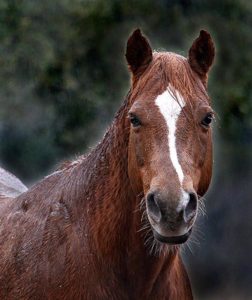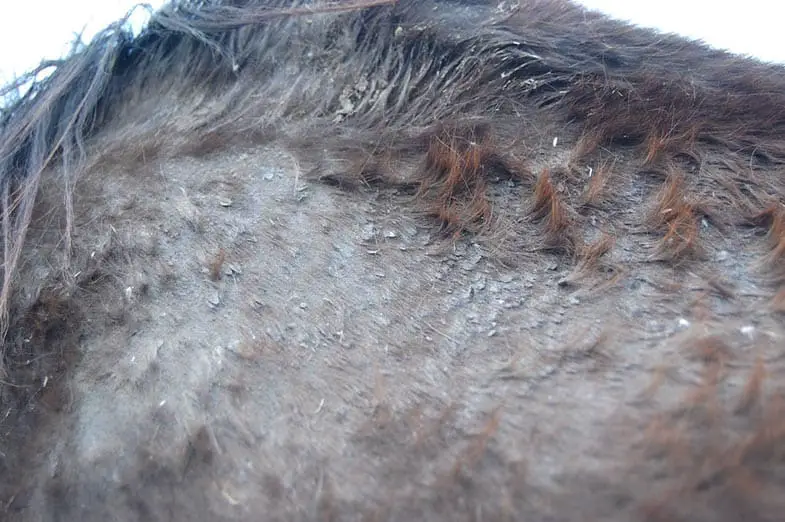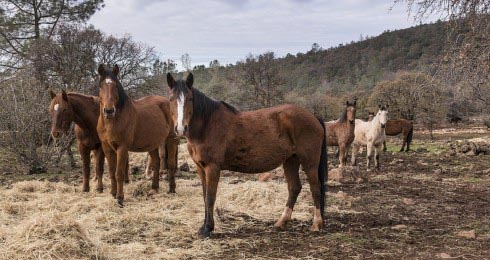When it starts to rain we tend to think that the best place for our horses is indoors (after all it’s what we prefer) but is it really what your horse wants? Research has shown that most horses would actually prefer to stay outside, but is that really what’s best for them?
Will a horse be okay if it’s left out in the rain? If a horse hasn’t been clipped and the rain isn’t too heavy (nor the wind too strong) then most horses can happily stay outside without any problems at all. They need their coat to keep warm so if they’ve been clipped then you should consider blanketing them.
Everybody has their own idea about whether it’s better to bring a horse in or not when it’s raining which can make it harder to know what the right thing to do is. Both sides make very valid cases but the simple fact is all horses are different and every condition is different so there is no 100% right or wrong answer which is why I decided to write this article. Over the decades I’ve owned many horses and have found (sometimes the hard way) what is best for them so I thought it would be helpful to lay down the facts so that you can make a better-informed decision about your horse’s winter care.
Is it okay to leave a horse out in the rain?
Horses have a naturally waterproof coat that helps to keep them warm and dry but, although this works perfectly most of the time, it’s not so effective when the rain is excessively heavy or lasts for a prolonged period of time. The problem is that the wetter their coat gets the more it clumps together and clings to their body. This means that the horse is no longer able to keep warm and can very quickly become extremely cold, and even suffer from hypothermia in some cases.
That doesn’t mean to say that the second the sky looks gray you should rush and bring your horse in, it just means they shouldn’t be left out in the open during heavy rain. If you’ve ever watched a horse in the rain you’ll notice that they’ll automatically seek refuge under a tree or large bush. We should follow their example and make sure they have a suitable shelter, only then will they be truly okay to leave out in the rain.
In the wild horses will use natural cover to shelter from the rain when it gets really heavy, employing this technique with the use of a shelter will allow your horse to stay out in the heaviest of rainstorms.
Can horses get sick from being in the rain?
Just because the rain itself won’t harm your horse (unless of course it flattens his coat and lets the cold in) doesn’t mean to say that the effects of the rain won’t have an adverse consequences for your horse. There are a number of conditions and issues that come about mainly due to the rain.
Leptospirosis
Thankfully comparatively rare, leptospirosis is a bacterial infection that can cause fever, abdominal pain, loss of appetite, and can even cause a mare to abort her foal. The organism lives under the soil normally when there’s been heavy rain the soil is disturbed and the bacteria is often moved to the surface where it can quickly spread to other pastures.
Rain rot
Sometimes called dew poisoning, rain rot is a bacterial skin condition that’s caused by a bacteria known as Dermatophilus Congolensis (or D. Congolensis for short). This bacteria lives naturally on a horse’s skin but wet and humid conditions can cause infections that result in dry scabby lesions on the areas that are exposed to the rain such as the back and neck.
The good news though is that this can be relatively easy to prevent but keeping your horse’s coat clean through regular grooming. That said though if you live in an area that’s prone to rain and high humidity it’s not always the case. In these circumstances, it’s best to not allow your horse to get too wet, or at least make sure he dries off quickly.
Mud fever
Similar to rain rot (and caused by the same bacteria), mud fever only affects the legs and is caused by the horse standing on wet and muddy ground for a long period of time. Normally the bacteria (which lives naturally on the skin) stays on the surface but when the skin is softened by mud the bacteria are able to break through the skin and cause an infection.
Hoof infections
Thrush is the most common hoof infection that mainly infects the frog (although it can sometimes affect the heel). It’s caused by prolonged exposure to water and can make it difficult for the horse to walk because it often leaves the sensitive hoof tissues exposed.
Mosquitoes
Many people don’t consider the effects that the rain can have on the mosquito population but it can, unfortunately, increase the numbers drastically, especially if the rain has caused a lot of standing water or you live in an area, such as Florida, with a lot of summer rain and high humidity.
While the mosquitoes themselves aren’t going to cause your horse any problems they can carry a lot of diseases so an effective insect management plan is essential.
How do I protect my horse from the rain?
While there’s nothing you can do about the rain (except move to an area with less rainfall) there are some steps you can take to reduce the impact of the rain on your horse.
Make sure your horse has a shelter
If you don’t do anything else to protect your horse from the rain you should at the very least provide him with some sort of shelter. Natural shelter is okay (and better than none at all) but a three-sided shelter would be the best option. This will allow the air to circulate but will also give him the option to seek refuge from the rain if he wants to.
Brush your horse regularly
Brushing your horse regularly can help to protect him from the rain in two ways. Firstly it’ll remove any mud from his coat, therefore reducing the chance of infection, but it can also stimulate the production of natural waterproofing oils. These oils will not only help to condition his coat (and give it extra shine) but they can also help to protect your horse from the rain by acting as a water repellant in his coat.
Use pig oil on your horse’s legs
If you’ve ever watched any cross country or eventing you’ll have noticed the horse’s chests are coated in a white substance, chances are this is pig oil which is great for waterproofing your horse’s legs. Spraying it lightly on his legs will stop the mud from sticking to them and therefore preventing conditions such as mud fever. Most tack stores will sell pig oil but if not you can easily buy it from Amazon.
Bandage your horse’s legs
If your horse’s legs do get really muddy then it might sound counterintuitive but wrapping them loosely in bandages will help the mud to dry off and is far better than hosing the legs down. Once it’s dry you can simply brush the mud off.
Trim your horse’s tail
If your horse’s tail is prone to getting really muddy during the winter months then trimming it a little will help to prevent this from happening and lower the risk of infection from the bacteria living in the mud. Don’t worry though, it’ll grow back ready for him to begin swatting flies again in the summer.
Don’t over blanket your horse
In most cases, the weather tends to be slightly milder when it’s raining so keeping this in mind when you’re blanketing your horse will reduce the chances of him overheating which has its own set of problems.
Spread hay about your horse’s pasture
If you keep your horse turned out during the winter (or at least for part of it) and feed hay in the pasture don’t put it all in one place. Putting smaller amounts in different places will prevent any one area from becoming excessively muddy and boggy. Avoiding putting it in heavily used areas such as gateways will also have the same effect.
Put straw on muddy areas
If you like a neat and tidy yard this isn’t for you but putting straw on top of muddy and/or wet areas of the pasture will help to absorb some of the water. It’ll also act as a bit of a barrier between the wet ground and your horse’s hooves and legs, to so will reduce the bogginess of the ground and give a little bit of cushioning to the ground too.
Make sure your horse has some boredom busters
If the weather is just too bad and you really have to bring your horse in then make sure you’ve got plenty of boredom busters to help keep him happy and stimulated while he’s stalled. Personally, I love to use a ground feeder such as a ball feeder (available from Amazon), but there are so many other options out there.
Can horses stay out during a thunderstorm?
You might be surprised but while some horses maybe a little frightened by the bright flashes or loud noises, most horses are more than happy being outside in a thunderstorm. In fact not only do most horses prefer it, but it is also actually often safer for them to be outside during a thunderstorm.
Some people will argue that if a horse is in an open field then it’s better to stall them during a storm because it reduces the chance of them getting injured. Of course, there is some logic to this, but there is also an argument that if a horse is outside it can keep moving and will therefore be safer. This is definitely true for tornadoes and hurricanes but in the case of lightning, it can travel so fast that I’m not sure if a horse could outrun it.
There’s no question that if a horse is in a field with trees they’ll be at a lesser risk of being struck by lightning but there is the possibility they could be injured as a consequence of a lightning strike on a tree which is why a lot of people choose to bring their horses in during a thunderstorm.
Essentially there is no right or wrong answer to whether or not you should bring your horse in during a storm, every owner has to do what’s best for them and their horse taking into account the conditions and the immediate risks.
Personally, I prefer to keep my horses out, it allows them to decide for themselves what’s in their best interest and gives them the ability to constantly react to the ever-changing conditions. The only two caveats I have though are that it’s of paramount importance that your horse has a suitable shelter. I also have a lightning rod close to the shelter so that it minimizes the chance of lightning hitting the shelter.
Future reading
- Should you always clip your horse?
- Best bedding for allergy prone horses
- Why do horses follow their owners?
- How to catch a difficult horse
- Why you shouldn’t punish your horse
- Preventing stall rest boredom
- Do horses get depressed
- How to keep a horse on a budget
- 10 alternative companions for horses
- Protecting your horse from sunburn
I hope you found this article helpful. If you did I’d be grateful if you could share it please as it would really help me.
Recommended products
Over the years I have tried hundreds of different horsey products, from various blankets and halters to different treats. Some I’ve loved, others I’ve hated but I thought I’d share with you my top all-time favorite products, the ones I never leave the yard without. I’ve included links to the products (which are in no particular order) that I really think are great.
- Horse Knots by Reference Ready – If you’re like me and enjoy pocket reference guides then you’ll love this knot tying guide. These handy cards can easily fit in your pocket or attach to the saddle for quick reference. They’re waterproof, durable and are color coded to make them easy to follow.
- Mane ’n Tail Detangler – Even if you never show your horse you’ll need to detangle his tail from time to time (and possibly his mane too) which is always a challenging chore! I’ve found that if I run a little bit of detangler through my horse’s tails every few days it stops them from getting matted up and makes combing them easy, even if they’re coated in mud. I don’t know if I should admit to this or not but it also works wonders on my hair.
- TAKEKIT Pro clippers – Over the years I’ve tried a lot of different clippers and while some were obviously better than others I found these to be by far the best. They are heavier than a lot of other clippers but for me, that’s a good thing, it makes them feel more sturdy and hardwearing. On top of that they have a range of speeds so are just as good for clipping your horse’s back as they are his face. I also like the fact that they come in a handy carry case but that’s not for everybody. The company that makes them is super good and incredibly helpful too, a real bonus these days. The only thing I wasn’t keen on was the fact that it doesn’t come with any oil, but that’s not a major problem as it’s not difficult to buy lubricant.
- Shire’s ball feeder – There are so many boredom buster toys out there but I like to use these every day, regardless of whether or not my horses are bored. I find that it helps to encourage my horses to problem solve by rewarding them with treats (or pieces of fruit) but it also mimics their natural grazing behavior which helps to keep them calm and de-stressed.
- Horse safe mirror – This is a strange one that many people are surprised about but I like to put horse safe mirrors in the trailers as well as in the quarantine stalls. It helps to prevent the feeling of isolation by giving the impression of other horses being around. Being herd animals horses can get extremely stressed when they feel that they’re on their own but with these stick-on mirrors, they believe that at least one other horse is with them.
- Rectal thermometer – I know this isn’t glamourous at all but it’s vital for your horse’s well-being to be able to check their temperature and a rectal thermometer is the easiest way of doing this which is why I’ve added it to the list.
Shopping lists
I’ve also put together a few shopping lists of essential items that I’ve found helpful over the years. I’ve broken the lists down into different categories rather than put everything in one massive list 😉





